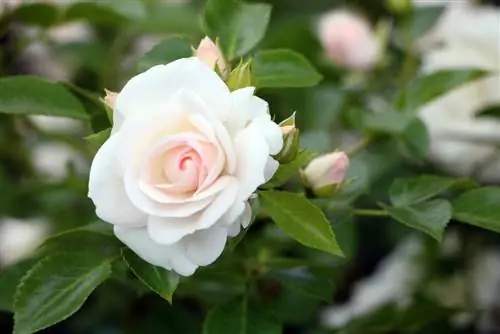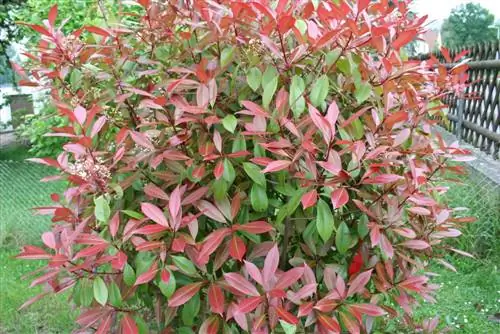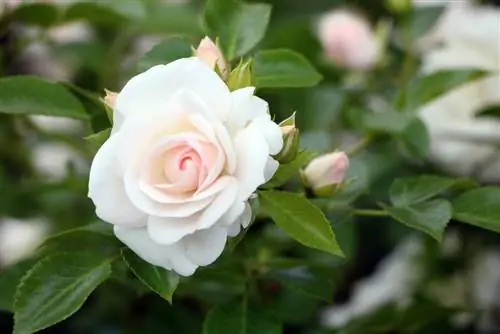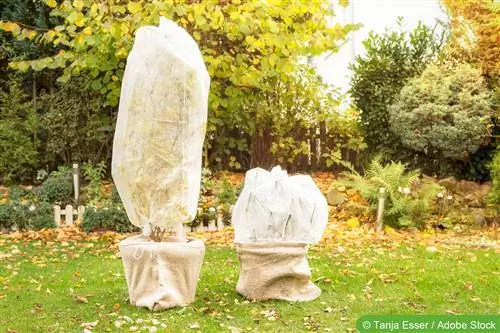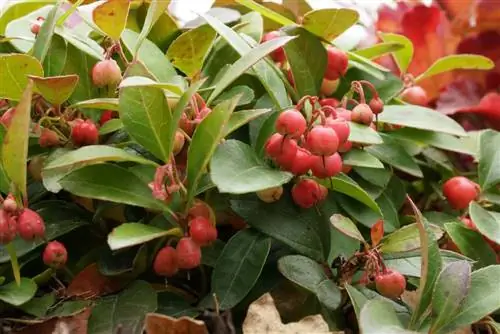- Author admin [email protected].
- Public 2023-12-17 03:39.
- Last modified 2025-01-24 12:45.
Roses in full bloom are a joyful sight. It's a shame we have to say goodbye to it in late fall. But the break from work was granted as a thank you to these miracles. Not entirely altruistic: the better they manage to hibernate, the more powerfully they will start the new spring. Are you alone in the cold or do you need a protective blanket from us?
Use insensitive varieties
The first foundation stone for successful overwintering is laid when a rose is replanted. Even if roses are considered hardy, the cold can cause major damage to them. The more resistance a rose plant has, the better it can cope with high temperatures below zero.
- some rose varieties are sensitive
- Diseases deplete the vitality of roses
- they start the winter weakened
- prefer less susceptible roses
- Rose variety should also suit the location
- As a beginner, it is better to start with a simple, robust variety
Tip:
Sick roses usually die over the winter. Therefore, always pay attention to the right care to maintain their vitality. Don't let pests weaken your roses without a fight. Because then the frost comes and robs them of their remaining strength.
Adjust fertilization in good time
During the summer, your rose needs plenty of fertilizer. Only then will it develop its full potential, which becomes clearly visible when it blooms. More and more shoots sprout from a few bare bushes. These are initially soft and green until they finally become completely woody after a while. This is important because only woody shoots are strong enough to withstand the cold.
- Autumn shoots do not have enough time to become woody
- therefore stop fertilizing early
- if the “fertilizer fuel” is missing, new shoots will not form
- existing shoots can mature
- The last fertilizer application should be at the end of July
Potassium for more plant power
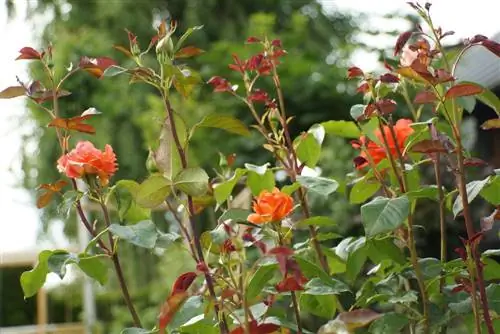
Many rose lovers pamper their roses with nutrients one last time in September. This is by no means a “summer fertilizer”. This contains nitrogen and stimulates the plant to grow. This is not desirable in autumn because there is not enough time for the new shoots to mature. The final fertilization is more about supporting the rose in the maturation of existing shoots.
- without nitrogen, instead fertilize with an emphasis on potassium
- with Patentkali or Thomas-Kali
- these mineral fertilizers strengthen the plant tissue
- Potassium, potassium and phosphorus are therefore helpful in maturing the shoots
- water abundantly after fertilization so that the fertilizer dissolves
Note:
Fertilizing with potash has many supporters among rose owners. Year after year, fertilizing with potash is an essential part of preparing your roses for winter. However, it should also be mentioned here that some plant lovers doubt the positive effects of potash.
Reserved and considered cutting
Roses that are cut in fall are more susceptible to frost damage. For this reason, the necessary cutting of roses should be postponed until spring. However, you can't do without scissors completely, even in autumn.
- refrain from major cutting measures
- remove a maximum of a third of the volume
- shorten excessively long shoots
- leave sturdy stems standing
- Remove shoots that overlap (one shoot)
- cutting away dead wood
- Pick up leaves from the ground
- and remove leaves from the rose bushes
- how to reduce the risk of disease transmission
Tip:
Radical cutting of roses is done in spring. If you want to know the optimal time, pay attention to the forsythia flowers. As soon as these plants turn yellow, the time has come for cutting roses.
pile up roses
In winter, all the power of roses rests in the rose roots. It is the guarantee for new growth in spring. Even though the rose is considered hardy and can expect sub-zero temperatures outdoors, its roots can still use our help. Nature protects the roses with a blanket of snow that warms their roots like a down blanket. We gardeners have to make provisions for the snow-free period.
- pile up a protective layer of soil around the roots
- about 15 to 20 cm high
- the mound should also cover the grafting area
- End of November to mid-December
- use loosened soil
- Moss, leaves and brushwood are also suitable
- no compost, no peat
- Bark mulch is also rather unsuitable
- Pine mulch, on the other hand, is good, but also expensive
- around the end of March the hill will be carefully removed again
Tip:
Pick up the rose petals from the ground before piling. If the leaves look diseased, they should not be added to the compost heap. Signs of illness include: E.g. spots, discoloration or malformed growth.
Sun protection against dehydration

Caring about sun protection in winter seems a little strange at first. In fact, sunny days are few and far between in winter, and even then the solar intensity remains weak. However, it is enough to trigger water evaporation. The shoots of the roses lose moisture. As a rule, this moisture is quickly replaced as the roots absorb new water from the soil. However, if the soil is frozen, water absorption is not possible. The result: the roses dry up. Since there is little that can be done to prevent the earth from freezing, the above-ground shoots of the rose must be protected from the sun's rays and therefore from excessive evaporation.
- There is a risk of drying out, especially in January and February
- then the combination of frost and sunshine occurs more frequently
- Take protective measures as early as autumn
- Cover roses with spruce or fir branches
- or wrap with fleece or jute
- Don’t remove protection too soon
- late frosts may follow until the end of April
- choose a mild and cloudy day to remove
- only a few days later the piled up earth is carefully removed
Note:
The sun protection also prevents the roses from being stimulated to sprout by the heat. It's definitely too early for that in spring.
Protect high tribes especially
Rose bushes are particularly decorative and are therefore very popular. In summer, caring for them doesn't differ much from other types of roses. However, special measures are required when overwintering them because they are different from other roses in one respect: their grafting point is below the crown. Piling up as protection is an unsuitable method here.
- Wrap the crown completely
- Use special foil
- Jute is also suitable
- airtight plastic bags are unsuitable
- they cause a greenhouse effect
- the rose sprouts too early
- However, she suffocates because there is no air exchange
- Wrap the crown in good time before the risk of frost
- Remove the wrapping again in spring
- The optimal time depends on the weather conditions
Tip:
Young standard trees are still quite flexible. An alternative option for them is piling up. The trunk is pressed flat down so that the entire crown can be lightly covered with soil.
Overwinter potted roses safely
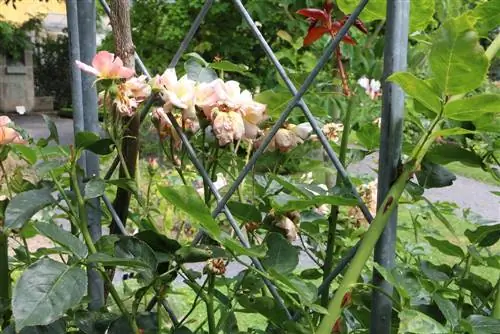
Rose plants that grow permanently in a pot are more exposed to the cold than planted specimens of the same variety. This is because the cold affects the bucket unhindered from all sides. At high temperatures below zero, the earth inside can freeze suddenly. This should be avoided at all costs. If you have suitable winter quarters, you can overwinter your roses there. They are in good hands there even in harsh winters.
- protected space
- dark
- free from frost
- but by no means warmed
- A garage is recommended
Roses that have to stay outside only survive very mild winters if left unprotected. Since such winters are rather rare here, frost protection is a must for anyone who loves their roses and wants to bring them safely into the next year.
- Wrap the pot for winter
- with non-woven fabric, jute, coconut mats or bubble wrap
- small pots can be placed in larger pots
- Fill the space with leaves
- create an insulating distance from the cold floor
- with Styrofoam, coconut mats or plant rollers
- also wrap the rose trunk with fleece, jute or coconut
- A location protected from wind and rain on the house wall is ideal
- best under the eaves
- Morning and evening sun are acceptable
- Midday sun is unfavorable
In spring, around the time the forsythia blooms, the winter protection can be removed again. Before the rose moves to its usual summer spot, it should first be acclimated to the sun in doses.
Tip:
Gardeners who have buried their potted roses and pot outside in the garden soil report good experiences. After being buried, these roses are protected like outdoor roses. They will be dug up again in the spring.
Caring for roses in winter
As soon as the roses are wrapped warmly and protectively, a rest period begins in which the need for care is reduced to a minimum. Outdoor roses require no further attention. Only the potted roses need a little water every now and then.
- water only moderately
- as soon as the soil is dry
- on frost-free days
- Avoid waterlogging at all costs
- the watering hole should always be free
- drain excess water from the saucer
Tip:
Check all your plants regularly for pest infestations and take appropriate control measures if necessary. Above all, the more plants are close together in a winter quarter, the easier it is for pests to spread.

